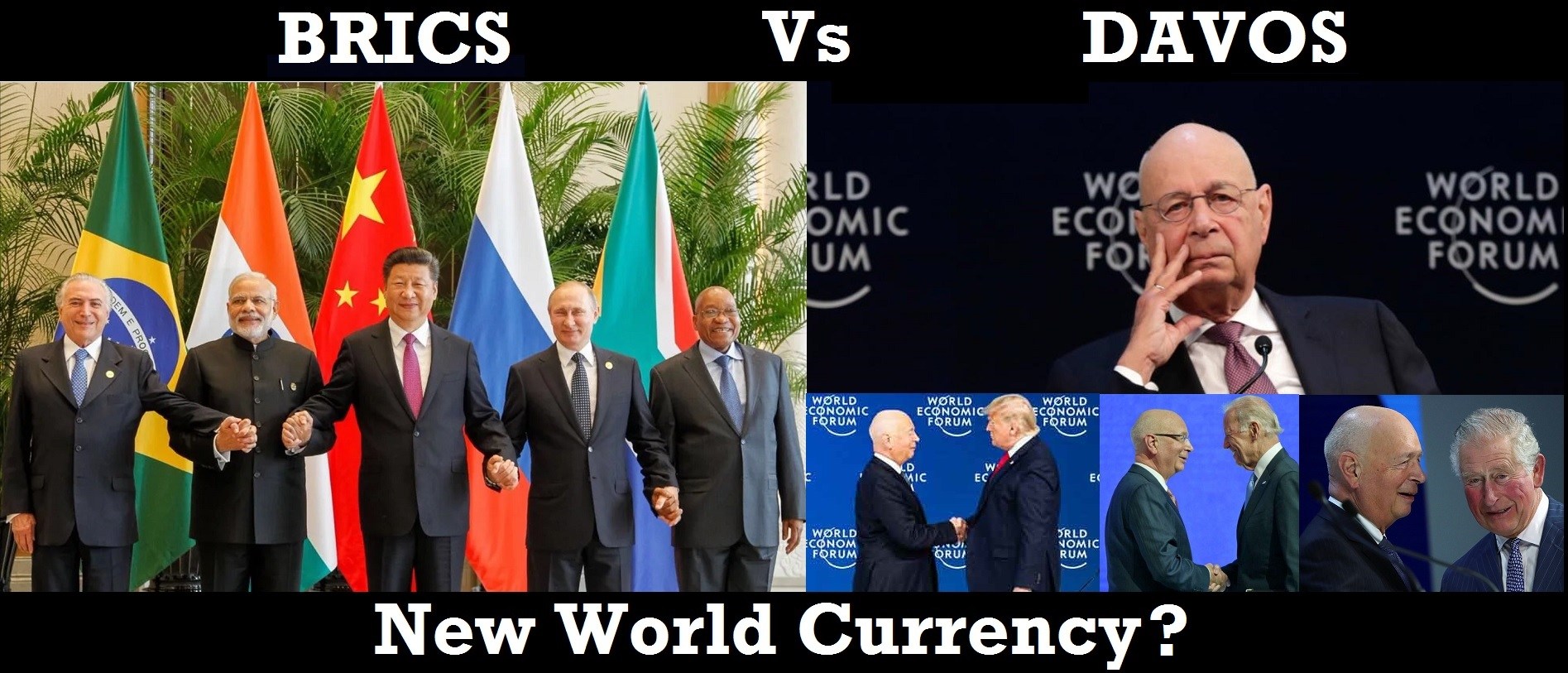BRICS vs. Davos: The Race to a New World Currency
Mon 3:44 pm +01:00, 10 Jul 2023by Brian Shilhavy
Editor, Health Impact News
We are truly living in historic times, as the world financial system is being transformed in real time here in 2023.
What is emerging are two competing forces to develop a new world currency.
The predominate world economic system is the one led by the Davos crowd, where the World Economic Forum(WEF) is the main institution that has controlled Western monetary policy, primarily in the U.S. and Europe, and also the rest of the world as they submitted to the Davos crowd, and their military alliance, NATO.
But the “rest of the world” is now joining forces to challenge the Davos crowd, led by BRICS (Brazil, Russia, India, China, South Africa), which now has a total of 41 countries wanting to join together with the original 5 BRICS nations and replace the U.S. dollar, currently the world’s dominate currency used in trade and finance, with a new, alleged gold-backed, world currency.
41 Countries Ready To Accept BRICS Currency a Month Before Summit
The list of countries ready to join the BRICS alliance and accept the new currency is growing. From a set of 19 countries in April, the numbers have spiked to 41 by the end of June. A total of 22 new countries expressed interest to enter the bloc and ditch the U.S. dollar in two months. The next BRICS summit will be held in August in South Africa where the bloc of five nations will combinedly decide the formation of a new currency.
BRICS is an acronym for Brazil, Russia, India, China, and South Africa. The decision to expand the alliance will be jointly taken in the next BRICS summit and the bloc could soon become BRICS+.
The total number of countries that could challenge the U.S. dollar on the global stage has reached 41. The developing nations that want to accept BRICS currency hail from Asia, Africa, and Eastern Europe.
The countries that have shown interest to join the BRICS alliance ahead of the summit are Afghanistan, Algeria, Argentina, Bahrain, Bangladesh, Belarus, Egypt, Indonesia, Iran, Kazakhstan, Mexico, Nicaragua, Nigeria, Pakistan, Saudi Arabia, Senegal, Sudan, Syria, the United Arab Emirates, Thailand, Tunisia, Turkey, Uruguay, Venezuela, and Zimbabwe.
Belarus is the first country in Eastern Europe that expressed interest to accept the new BRICS currency. On the other hand, France has also shown its interest to attend the next BRICS summit in South Africa.
Additionally, many countries in Africa remain on the sidelines and could announce their support for the BRICS currency after its launch. Kenya has urged African nations to stop using the U.S. dollar and trade with native currencies within the continent. (Source.)
The Davos crowd, on the other hand, realizes that their banking system is in serious trouble, and they have been working on a plan to replace fiat currencies such as the U.S. dollar, with Central Bank Digital Currencies (CBDC).
The Bank for International Settlements based out of Switzerland, and the International Monetary Fund, a United Nations institution based out of Washington D.C., are the two predominant groups working quickly to develop a standard for CBDCs.
BIS: CBDC Roll-Outs May Require Changing The Constitution
The IMF is warning that with all these CBDCs about to launch, there need to be global inter-operability standards between them all, and they’re working on a global platform to facilitate just that.
Speaking at a conference of African central banks in Rabat, Morocco, IMF Managing Director Kristalina Georgieva said that there needs to be agreement among CBDC implementations,
“on a common regulatory framework for digital currencies that will allow global interoperability. Failure to agree on a common platform would create a vacuum that would likely be filled by cryptocurrencies”
Not to be outdone, the Bank of International Settlements (BIS) worked with seven central banks to publish YARP (Yet Another Research Paper) on CBDC policy, entitled “Central Bank Digital Currencies: ongoing policy perspectives”…
The central banks involved were: Japan, Sweden, Switzerland, England, the United States, Canada, and the European Union.
“Development of CBDC work requires careful consideration and engagement with a wide range of stakeholders, including the private sector and legislators”…
“To successfully meet its public policy objectives, a CBDC ecosystem should allow a wide range of private and public stakeholders to participate and, in doing so, deliver services which benefit end users.”…
“The complex design questions and the potential risks arising from the implementation of any CBDC require careful consideration.”
The paper wonders: Are they cash? Deposits? Or something else entirely?
Further, the paper wonders, would there need to be changes to banking charters, legislation or even the constitutions of the countries issuing them:
“Legislation may need to be enacted or adjusted to specifically authorise the issuance and distribution of a retail CBDC (eg changes to central bank charters/statutes, legislation in other areas related to payments or to the constitution itself)”
Read the full article.
https://healthimpactnews.com/2023/brics-vs-davos-the-race-to-a-new-world-currency/












